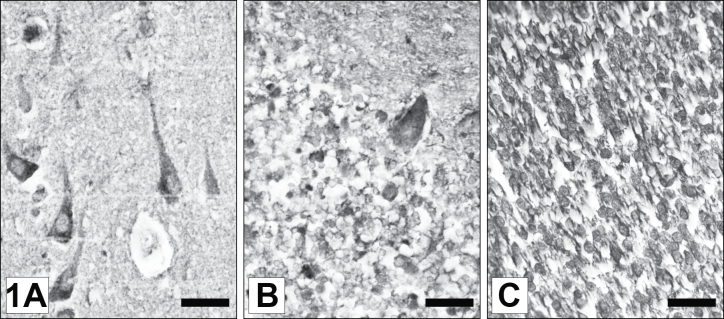To the editor:
We read with great interest the recently published article by Schultz and colleagues1 about the putative link between the expression of the zinc finger protein ZNA 804A and the cortical structure in schizophrenia and wish to comment from a “human neuroanatomical” perspective on selected aspects of this topic. A single-nucleotide polymorphism (SNP) rs1344706 in the intron of the zinc finger protein ZNF804A (rs1344706) is a replicated genetic risk variant associated with schizophrenia (reviewed in Hill and Bray2). In the endeavor to learn more about the role of ZNF804A in schizophrenia, Schultz et al1 performed a comprehensive allelic-specific gene expression study (homozygous risk allele AA carriers vs AC/CC carriers), combining magnetic resonance imaging cortical thickness and folding computing in genotyped patients with schizophrenia and healthy controls. Furthermore, they analyzed ZNF804A gene expression in a prefrontal region using postmortem tissue of schizophrenia patients and controls. It was revealed that in patients, AA carriers exhibited thicker cortex in prefrontal and temporal regions and less disturbed superior temporal cortical folding than AC/CC carriers, whereas the opposite effect was found in control cases. In addition, the expression analysis showed that the risk allele is associated with lower prefrontal ZNF804A expression in patients. This and other studies clearly imply that the expression of ZNF804A (and its gene variants) significantly impacts the developmental organization of human brain, both in health and disease. Indeed, the ZHF804A is thought to be prominently involved in brain development by influencing neural migration, neurite outgrowth, and the formation of synapses3 and was shown to be highly expressed in fetal (peaking in the second trimester) but not adult human brain.2 To better understand the role of ZNF804A in normal and disease-related brain development, it would be very important to know the regional and cellular expression of this protein in developing brain and adult human brain. Amazingly enough, this aspect has not been studied so far. We therefore immunohistochemically analyzed the expression patterns of ZNF804A protein in 4 adult human brains from psychically healthy individuals (3 males, 1 female; aged between 43 and 55 years) and 4 fetal brains (17th, 19th, 22nd, and preterm 28th gestational weeks). All brains were obtained from the Magdeburg brain collection.4 Case selection procedures, the acquisition of personal data, autopsies, and the handling of autoptic material were all conducted in strict accordance with the Declaration of Helsinki and were approved by the responsible Magdeburg Ethics Committee. In adult brains, we found a wide neuronal expression in the cortex (figure 1A), thalamus, hippocampus, hypothalamus, cerebellum (figure 1B), and brain stem. In mid-gestational brains, ZNF 804A was highly expressed in multiple neuroblasts and radial glial cells (figure 1C). Our findings strongly support, from a neuroanatomical viewpoint, the notion that ZNF804A might be an important player in neurodevelopmental processes.1–3 However, its relatively high expression in mature human brain neurons leads us to assume that ZNF804A is relevant for adult brain functioning as well. Especially the strong expression of this protein in normal cortical neurons (together with a proposed altered neuronal expression pattern in schizophrenia) might well contribute to differences in cortical thickness between schizophrenia and control brains as observed by Schultz et al1 and others. Whether or not the cellular expression patterns of ZNA804A is really altered in schizophrenia is currently completely unknown. We therefore are about to conduct an immunohistochemical study on ZNF804A localization in brains of schizophrenics and healthy controls with and without the SNP rs1344706 to learn more about the cellular consequences of this mutation.
Fig. 1.
Immunohistochemical demonstration of ZNF 804A in adult and developing human brain. (A) Temporal cortex of a 49 years old male. TNF 804A is expressed in layer III pyramidal cells and interneurons. (B) Cerebellum of a 55 years old female. A vast majority of granule cells and a few Purkinje cells were found to express the protein. (C) ZNF 804A expression in the cortex anlage of a fetal brain (19th gestational week). Multiple neuroblasts and radial glial cells are intensely immunostained. Scale Bars (valid for figures 1A–C) = 25 µm.
Acknowledgment
The authors have declared that there are no conflicts of interest in relation to the subject of this study.
References
- 1. Schultz CC, Nenadic I, Riley B, et al. ZNF804A and cortical structure in schizophrenia: in vivo and postmortem studies [published online ahead of print September 2008]. Schizophr Bull. 2013 [DOI] [PMC free article] [PubMed] [Google Scholar]
- 2. Hill MJ, Bray NJ. Evidence that schizophrenia risk variation in the ZNF804A gene exerts its effects during fetal brain development. Am J Psychiatry. 2012;169:1301–1308 [DOI] [PubMed] [Google Scholar]
- 3. Hill MJ, Jeffries AR, Dobson RJ, Price J, Bray NJ. Knockdown of the psychosis susceptibility gene ZNF804A alters expression of genes involved in cell adhesion. Hum Mol Genet. 2012;21:1018–1024 [DOI] [PubMed] [Google Scholar]
- 4. Bernstein HG, Stricker R, Dobrowolny H, et al. Nardilysin in human brain diseases: both friend and foe. Amino Acids. 2013;45:269–278 [DOI] [PubMed] [Google Scholar]



